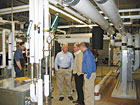
The Rock River Reclamation District headquarters in Rockford, Ill., is a LEED-certified facility that also was the site for a tour taken by attendees at a meeting of the Northern Illinois Branch of the Chicago Chapter of the U.S. Green Building Council.
ROCKFORD, Ill. - The year 2009 was a time of change and adjustments in many aspects. For the Leadership in Energy and Environmental Design (LEED) program, it was a year to put in place refinements in the program designed to create better “credit harmonization, credit weighing, regionalization, and updating of standards.”
Aspects of all that were covered at a meeting near the end of the year of the Northern Illinois Branch of the Chicago Chapter of the United States Green Building Council (USGBC).
Doug Widener, chair of the Chicago Chapter, noted LEED has a point system designed to give recognition to construction projects that focus on energy conservation and environmental awareness. In fact, the northern Illinois meeting followed a tour the month before of the Rock River Reclamation District headquarters that had just gained LEED certification. That event included a tour of the facility that was cited for use of a water-source heat pump with heat rejection to wastewater, use of daylight, and optimizing the building envelope. It was also noted the water reclamation district recovers biogas for on-site power generation.
For the meeting that followed, the focus was on changes in LEED. Widener said the goal of the updated LEED point system was “an alignment between rating systems for similar credits with all rating systems based on 100 points.” Measurements include sustainability of the site, water efficiency, energy usage, materials used, indoor environmental quality, awareness and education, innovation in design, and regional priority.
One emphasis, he said, is now on “more weighing to climate change.” In addition to IAQ, a project will be looked at in terms of its “resource depletion” and “human health criteria.”

Michael Dudek, chair of the Northern Illinois Branch of the Chicago Chapter of the U.S. Green Building Council, discusses some of the latest developments in LEED certification at a branch meeting.
He drew attention to the Green Building Certification Institute, a third party provider of project certification. The GBCI was set up with the support of USGBC to “administer the credentialing programs related to green building practice and standards,” according to USGBC.

Attendees at a meeting of the Northern Illinois Branch of the Chicago Chapter of the U.S. Green Building Council view some of the HVAC system at the Rock River Reclamation District headquarters, which is a LEED-certified facility.
TIERS
The familiar LEED Accredited Professional (AP) program is also getting flanked with the LEED Green Associate credential and eventually a LEED Fellow credential. It was noted that the LEED Green Associate is “for professionals who want to demonstrate green building expertise in non-technical fields of practice. It represents demonstrable knowledge and core understanding of green building practices and principles and the LEED rating system in order to support sustainable design, construction, and operations,” according to a statement from the USGBC.That Tier I program is followed by the LEED AP in Tier II. “LEED AP will continue to signify an advanced depth of knowledge in green building practices, and will add the ability to specialize in particular fields such as commercial operations and maintenance, or residential design and construction.” There are now five LEED AP tracks: operations/maintenance, homes, building design and construction, interior design and construction, and neighborhood development.
Widener also noted that looking beyond 2009, plans are underway to develop the LEED Fellow credential as a Tier III. It was described as “an elite class of leading professionals who would be distinguished by their experience and contributions to advancing green building knowledge and practice.”
Publication date:02/22/2010

